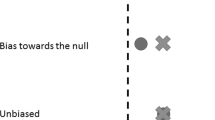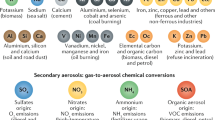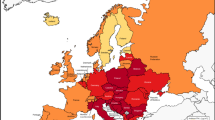Abstract
Air pollution health effect studies are intended to estimate the effect of a pollutant on a health outcome. The definition of this effect depends upon the study design, disease model parameterization, and the type of analysis. Further limitations are imposed by the nature of exposure and our ability to measure it. We define a plausible exposure model for air pollutants that are relatively nonreactive and discuss how exposure varies. We discuss plausible disease models and show how their parameterizations are affected by different exposure partitions and by different study designs. We then discuss a measurement model conditional on ambient concentrations and incorporate this into the disease model. We use simulation studies to show the impact of a range of exposure model assumptions on estimation of the health effect in the ecologic time series design. This design only uses information from the time-varying ambient source exposure. When ambient and nonambient sources are independent, exposure variation due to nonambient source exposures behaves like Berkson measurement error and does not bias the effect estimates. Variation in the population attenuation of ambient concentrations over time does bias the estimates with the bias being either positive or negative depending upon the association of this parameter with ambient pollution. It is not realistic to substitute measured average personal exposures into time series studies because so much of the variation in personal exposures comes from nonambient sources that do not contribute information in the time series design. We conclude that general statements about the implications of measurement error need to be conditioned on the health effect study design and the health effect parameter to be estimated.
This is a preview of subscription content, access via your institution
Access options
Subscribe to this journal
Receive 6 print issues and online access
$259.00 per year
only $43.17 per issue
Buy this article
- Purchase on Springer Link
- Instant access to full article PDF
Prices may be subject to local taxes which are calculated during checkout
Similar content being viewed by others
References
Allen R., Larson T., Wallace L., Sheppard L., and Liu L.-J.S. Use of real-time light scattering data to estimate the contribution of infiltrated and indoor-generated particles to indoor air. Environ Sci Technol, 2003: 37: 3484–3492.
Burke J.M., Zufall J.J., and Ökaynak H. A population exposure model for particulate matter: case study results for PM2.5 in Philadelphia, PA. J Expos Anal Environ Epidemiol 2001: 11: 470–489.
Carroll R.J., Ruppert D., and Stefanski L.A. Measurement Error in Nonlinear Models. Chapman & Hall, New York, 1995.
Clayton D. Models for the longitudinal analysis of cohort and case–control studies with inaccurately measured exposures. In: Dwyer, J.H., Feinleib, M., Lippert, P., Hoffmeister, H. (Eds.). Statistical Models for Longitudinal Studies of Health of Monographs in Epidemiology and Biostatistics Vol. 16. Oxford University Press, Oxford, 1991, pp. 301–331, Chapter 12.
Dominici F., Daniels M., Zeger S.L., and Samet J.M. Air pollution and mortality: estimating regional and national dose-response relationships. J Am Statist Assoc 2002: 97(457): 100–111.
Dominici F., Zeger S.L., and Samet J.M. A measurement error model for time-series studies of air pollution and mortality. Biostatistics 2000: 12: 157–175.
Duan N. Stochastic microenvironmental models for air pollution exposure. J Expos Anal Environ Epidemiol 1991: 1(2): 235–257.
Firebaugh G. A rule for inferring individual-level relationships from aggregate data. Am Sociol Rev 1978: 43: 557–572.
Gilks W.R., and Richardson S. Analysis of disease risks using ancillary risk factors, with application to job-exposure matrices. Statist Med 1992: 11: 1443–1463.
Janssen N.A.H., Schwartz J., Zanobetti A., and Suh H.H. Air conditioning and source-specific particles as modifiers of the effect of PM10 on hospital admissions for heart and lung disease. Environ Health Perspect 2002: 110(1): 43–49.
Koutriakis P., Briggs S., and Leaderer B. Source apportionment of indoor aerosols in suffolk and onondaga counties, New York. Environ Sci Technol 1992: 26: 521–527.
Kunzli N., and Tager I.B. The semi-individual study in air pollution epidemiology: a valid design as compared to ecologic studies. Environ Health Perspect 1997: 105: 1078–1083.
Liu L.-J.S., Box M., Kalman D., Kaufman J., Koenig J., Larson T., Lumley T., Sheppard L., and Wallace L. Exposure assessment of particulate matter for susceptible populations in Seattle, WA. Environ Health Perspect 2002: 111: 909–918.
Mage D., Wilson W., Hasselblad V., and Grant L. Assessment of human exposure to ambient paticulate matter. J Air Waste Manage Assoc 1999: 49: 1280–1291.
National Research Council Committee on Research Priorities for Airborne Particulate Matter. Research Priorities for Airborne Particulate Matter: Immediate Priorties and a Long-Range Portfolio, National Academy Press, Washington, DC, 1998.
National Research Council Committee on Research Priorities for Airborne Particulate Matter. Research Priorities for Airborne Particulate Matter: III Early Research Progress, National Academy Press, Washington, DC, 2001.
Ott W., Wallace L., and Mage D. Predicting particulate (PM10) personal exposure distributions using a random component superposition model. J Air Waste Manage Assoc 2000: 50: 1390–1406.
Piantadosi S., Byar D.P., and Green S.B. The ecological fallacy. Am J Epidemiol 1988: 127(5): 893–904.
Salway R., and Wakefield J. Sources of bias in ecological studies of non-rare events. Environmental-Ecological Statistics, in press.
Schwartz J., Laden F., and Zanobetti A. The concentration-response relation between PM2.5 and daily deaths. Environ Health Perspect 2002: 110: 1025–1029.
Sheppard L. Ecologic study design. In: El-Shaarawi, A.H., Pierorcsh, W.W. (Eds.). Encyclopedia of Environmetrics, Vol. 2. John Wiley and Sons, New York, 2002, pp. 602–606.
Sheppard L. Insights on bias and information in group-level studies. Biostatistics 2003: 4: 265–278.
Sheppard L., and Damian D. Estimating short-term PM effects accounting for surrogate exposure measurements from ambient monitors. Environmetrics, 2000: 11: 675–687.
Sheppard L., and Prentice R.L. On the reliability and precision of within and between population estimates of relative rate parameters. Biometrics 1995: 51: 853–863.
Wilson W.E., Mage D.T., and Grant L.D. Estimating separately personal exposure to ambient and nonambient particulate matter for epidemiology and risk assessment: why and how. J Air Waste Manage Assoc 2000: 50: 1167–1183.
Yu O., Sheppard L., Lumley T., Koenig J.Q., and Shapiro G. Effects of ambient carbon monoxide and atmospheric particles on asthma symptoms: results from the CAMP air pollution ancillary study. Environ Health Perspect 2000: 108: 1209–1214.
Zeger S.L., Thomas D., Dominici F., Samet J.M., Schwartz J., Dockery D., and Cohen A. Exposure measurement error in time-series studies of air pollution: concepts and consequences. Environ Health Perspect 2000: 108: 419–426.
Zidek J.V., Jeloche J., Shaddick G., Chatfield C., and White R. A computational model for estimating personal exposure to air pollutants with application to London's PM10 in 1997. Technical Report 2003-3, Statistical and Applied Mathematical Sciences Institute, RTP, NC, 2003.
Zidek J.V., Meloche J., Le N.D., and Sun L. Combining statistical and Computer models for health risk assessment (exposure analysis). In: Nex-Antn, V., Feffeirra, E. (Eds.). Statistical Modeling. Proceeings of the 15th International Workshop on Statistical Modelling: New Trends in Statistical Modelling, Universidad del Pais Vasco, Bilbao, 2000, pp. 95–106.
Acknowledgements
This work was supported by Grants ES08062-03 from the National Institute of Environmental Health Sciences, NIH and R827355 from the US Environmental Protection Agency. The contents are solely the responsibility of the authors and do not necessarily represent the official views of NIEHS or EPA.
Author information
Authors and Affiliations
Corresponding author
Rights and permissions
About this article
Cite this article
Sheppard, L., Slaughter, J., Schildcrout, J. et al. Exposure and measurement contributions to estimates of acute air pollution effects. J Expo Sci Environ Epidemiol 15, 366–376 (2005). https://doi.org/10.1038/sj.jea.7500413
Received:
Accepted:
Published:
Issue Date:
DOI: https://doi.org/10.1038/sj.jea.7500413
Keywords
This article is cited by
-
Influence of exposure measurement errors on results from epidemiologic studies of different designs
Journal of Exposure Science & Environmental Epidemiology (2020)
-
Individual-level modifiers of the acute effects of air pollution on mortality in Wuhan, China
Global Health Research and Policy (2018)
-
The effect of meteorological conditions and air pollution on the occurrence of type A and B acute aortic dissections
International Journal of Biometeorology (2018)
-
Spatial measurement errors in the field of spatial epidemiology
International Journal of Health Geographics (2016)
-
Effects of ambient air pollution measurement error on health effect estimates in time-series studies: a simulation-based analysis
Journal of Exposure Science & Environmental Epidemiology (2015)



